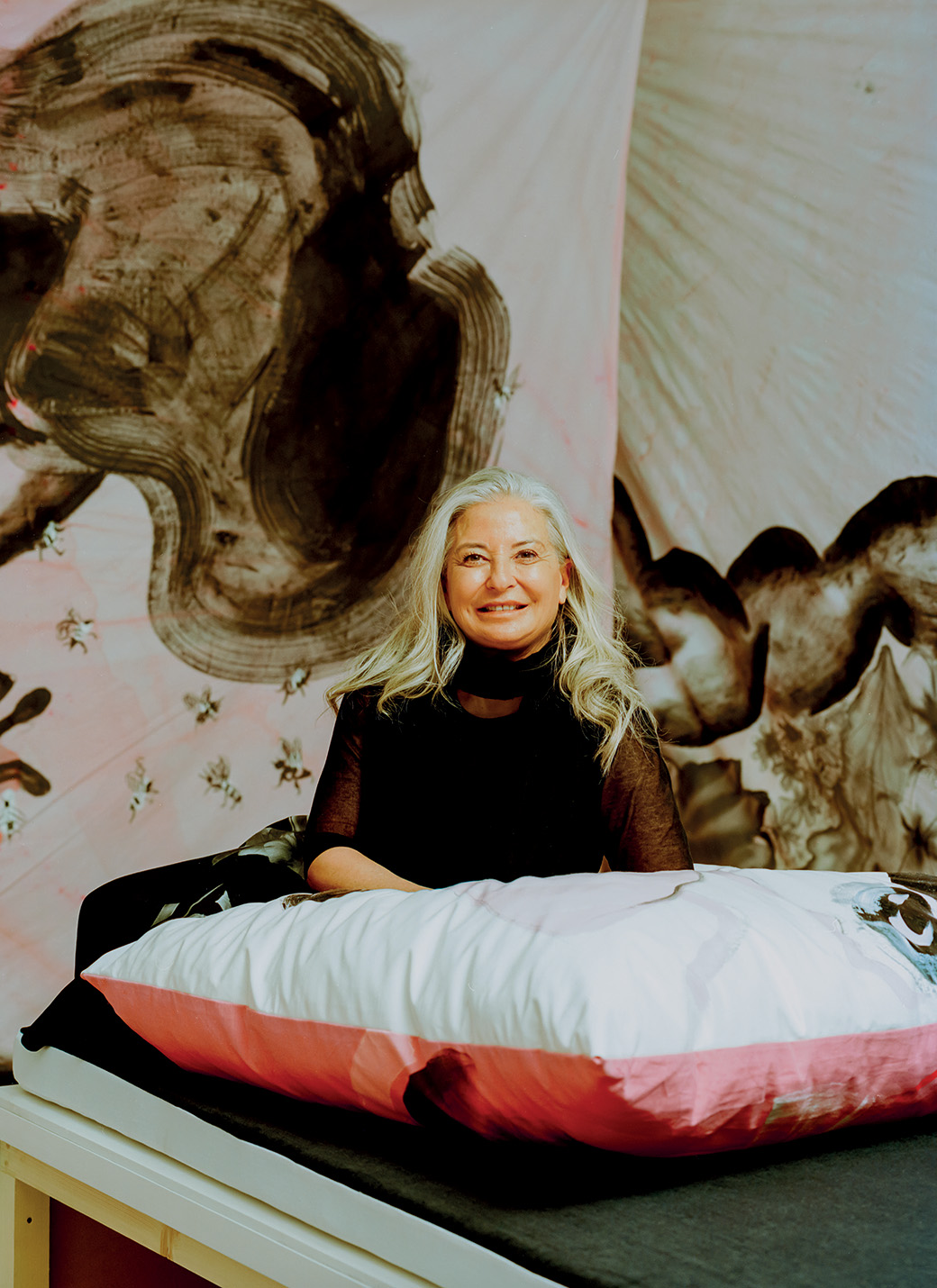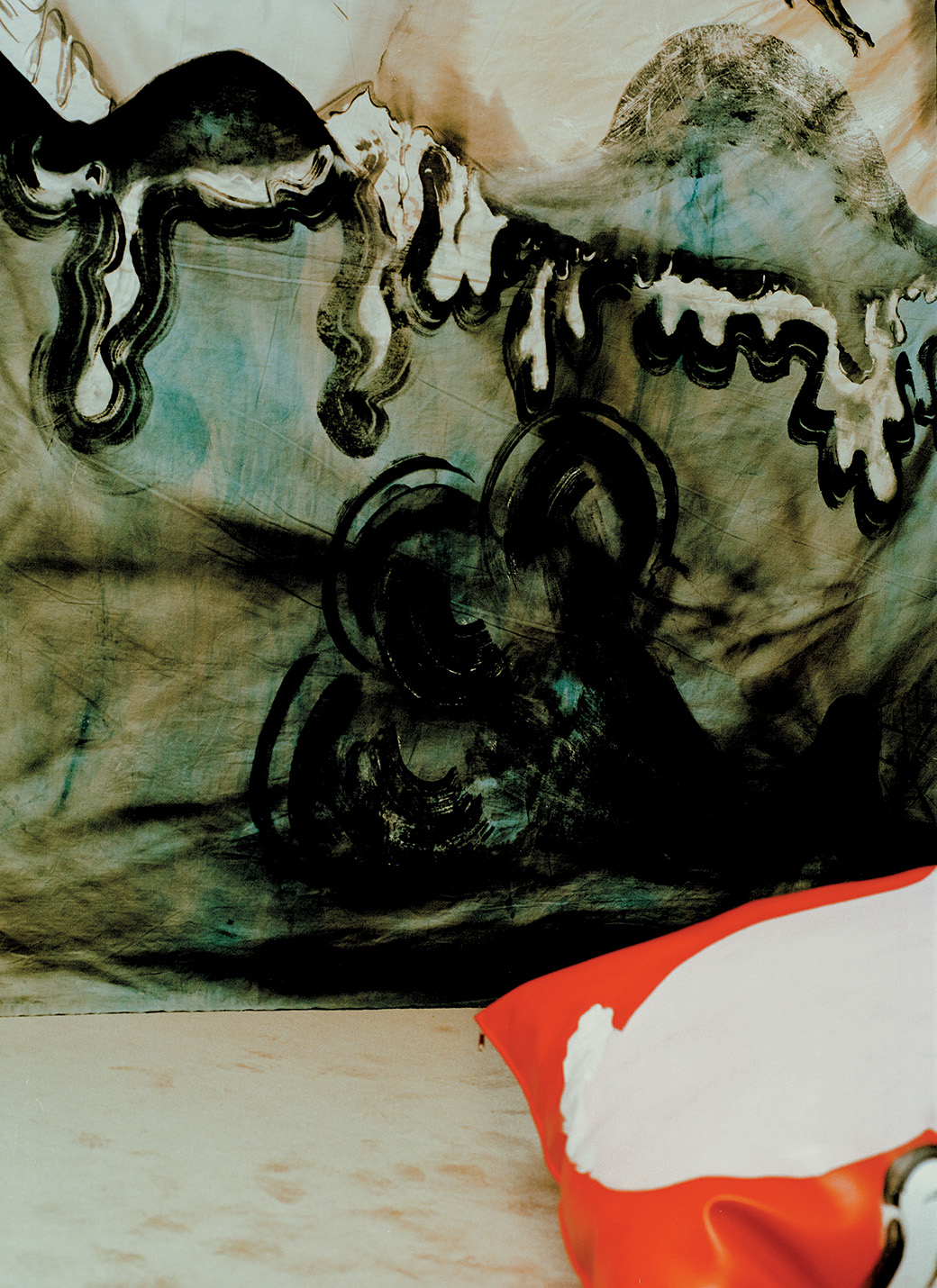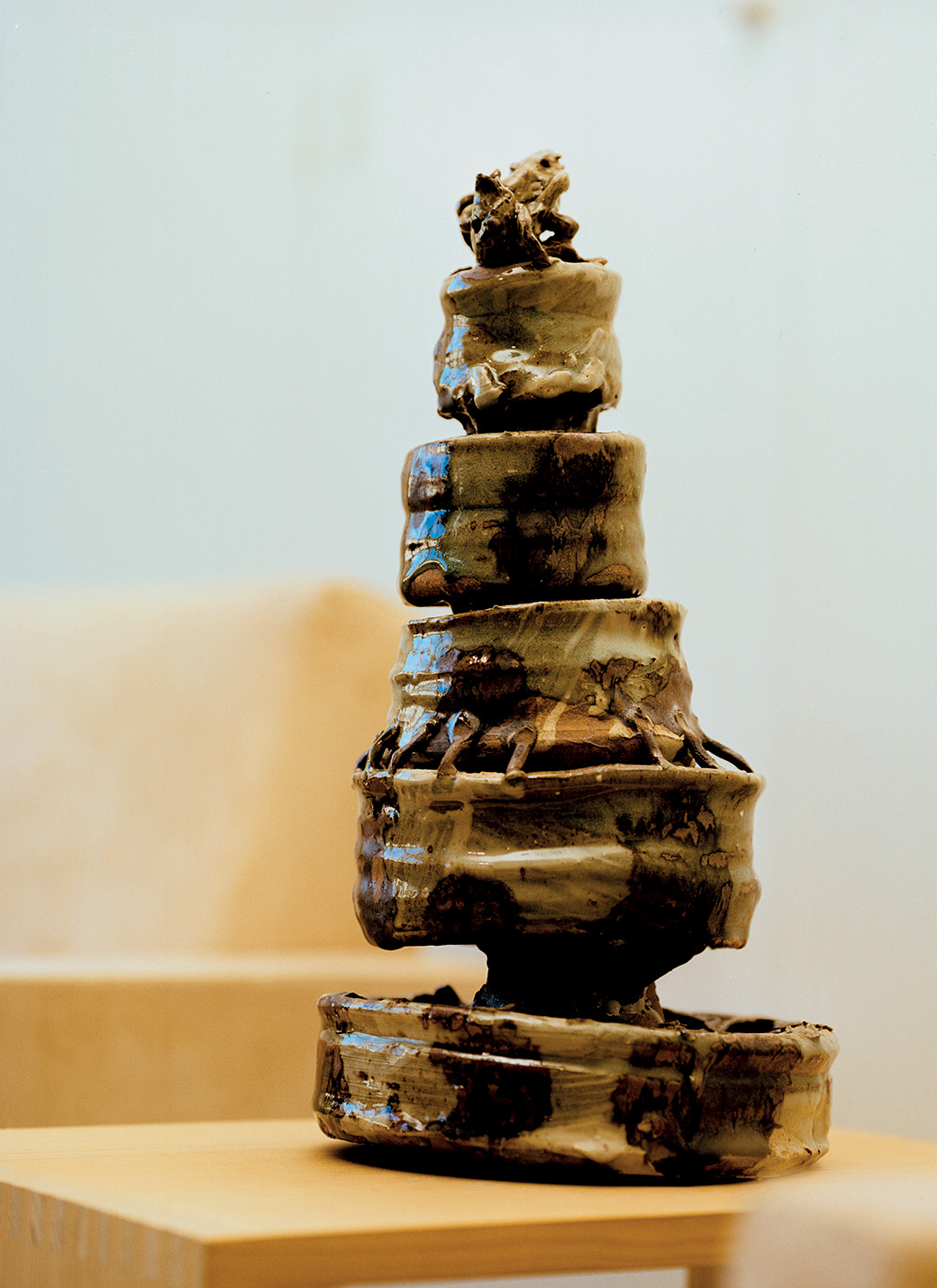Tea Break with Silvia Fiorucci
At Le Quai in Monte Carlo
Conversation with Bianca Felicori Photography Mattia Parodi

-
It’s impossible to describe Silvia in just a few lines. I like her. I know it the instant I see her. I glimpse her story in her bright, lively eyes and hidden bashfulness. I discover the shape and content of a multifaceted tale that got her to where she is today, sitting next to me on a sofa in her new exhibition space in Monte Carlo. At a certain point in her life, Silvia Fiorucci, the great Italian dressage champion, decided to reinvent herself and change the rules of the game, dedicating herself to art and becoming a generous collector. She chose to completely ignore the traditional way of doing things, becoming a point of reference for a community that is now known as the Società delle Api (The Bee Society). Her love for art is driven by emotion and materialises in the immense joy that she feels in front of her pieces, which fill her homes. Sitting in front of an incredible table service by Valentina Cameranesi, in a room flooded with the light of a warm April day and enjoying some leftover Easter chocolate, she tells me her story.
-
BFWe’ve known each other for 24 hours, but it feels like 10 years.
-
(Silvia and Cristiano laugh)
-
BFWhen did you decide to start collecting? After a successful career in horse riding, what drove the transformation into the Silvia you are today?
-
SFI was a professional athlete, I rode in lots of international competitions and won the most important Italian championships. I started collecting at a specific moment in my life when I went through some radical changes. I stopped horse riding and I decided to take a new path because I wanted to give new sense to my life, I wanted to feel different emotions.
-
BFWas there any moment in particular that influenced this new adventure?
-
SFI was looking for something new to bring me joy and to fill the void that I felt inside. I met Cristiano Raimondi, who was director of the Nouveau Musée National de Monaco at the time and would be a key figure in making sense of my collection today, along with Marie-Claude Beaud, former director of the museum. Julien Rodier, my assistant at the time and today Councillor for Culture of the Hérault region, introduced me to Carine Delanoë-Vieux, director of the laboratory for cultural innovation through design at the GHU Paris Psychiatry and Neuroscience. Carine helped me to work out what I was feeling and what I needed.
-
BFWhat happened with Carine and Julien exactly?
-
SFCarine helped me to establish some mental order and understand what I felt inside and what I wanted, she helped me to open my heart and relieve some of the tension that we all suffer from. I’ve always struggled with dialogue because I’m dyslexic, which is something that wasn’t considered an issue when I was young. I was able to treat it over the years, but I never managed to shake off that sense of emptiness that Carine helped me to work through. I still struggle to express myself and what I feel inside.
-
BFSo this was about finding a new way to express yourself...
-
SFYes, my passion for art is driven by emotion, I choose to purchase a piece on the basis of what I feel the first time I see it. There aren’t many faces in my collection, for example, because they make me feel anxious and I try to avoid them. I find far more peace in abstract works. I do have some in my collection though because I fell in love with them, by artists such as Miriam Cahn, Vaginal Davis. They are faces that have been revisited with the techniques used by the artists though. The most important thing for me is to feel that a piece is mine.
-
BFYour love for art is instinctive.
-
SFI don’t have any artistic training. My father was a collector of ancient art, so it’s a passion that we’ve always had in the family. My mother collected drawings and my sister is a collector as well. Everything that I have built in these years comes from the heart, from my emotions and from various encounters with different people.
-
BFThose encounters have been fundamental. You have built an incredible network of people around you, such as Cristiano Raimondi. How did you two meet?
-
SFWe met because I was drawn to the Monaco museum when I started collecting. We immediately clicked.
-
(“But we’re total opposites”, adds Cristiano who has just come into the room. Silvia laughs.)
-
SFEarly on, I took part in the visits organised by Cristiano as a member of the “Friends of the Museum” association. I learned how to understand art and its nuances, how to read a painting. We grew closer and closer to the point that Cristiano started advising me on what to look at and what to buy. What gave me a lot of faith in both myself and our relationship was that Cristiano never imposed2, he guided my growth but I was free to make my own decisions.
-
(“We both grew”, interjects Cristiano)
-
SFI have to say that we click on many levels. We both like researching and being around young artists and designers because they give us so much energy. You feel recharged by spending time with them because they are so full of enthusiasm, life and ideas.
-
BFOne of the most interesting aspects of your Society is the way that you have created a very human network and I understand that even more now that I’ve met you.
-
SFIt’s almost an algorithm. Artists like Sofia Stevi, who is exhibiting today in our new space and with whom we have organised various residences, are part of a natural and intuitive process. There is no curatorial strategy behind it, it’s the normal evolution of a journey that you go on with the artist.

-
BFIt seems as though you keep adding new pieces to the puzzle. What criteria do you use for your research into artists and designers? The collection is far from conventional, it’s not just made up of big names, in fact there are relatively few big names. It feels as though you look for more forgotten artists or even actively stimulate the development of new emerging figures.
-
SFI think that the leitmotif of our collection is freedom of choice and the emotion you feel looking at each piece in the collection. And people really love the collection.
-
BFNo mean feat!
-
(Silvia laughs)
-
SFEvery piece has its own personal and biographical story, a memory. Each one contains the emotions felt when it was seen the very first time. Going to the fairs and deciding what to buy is also an experience for us. Collecting for me is a form of freedom. I feel the same way I feel when sailing, I feel free. I feel this explosion of inner joy which makes me fall in love with something and want to put it with the others.
-
BFAnd you live with your pieces. They are in your home, your studio...
-
SFWhat’s the point otherwise? You can find my collection in all my homes and I feel very much at home with it. When I’m away, I always want to get back to Monaco, not to the city but to be at home and see all my things around me. Same for Rome.
-
BFSome of your homes are for you and your collection to live in but am I right that you have transformed others into artist residences?
-
SFI became a mother at a very young age, I have two children and five grandchildren. My children live in the US, they are very far away but that’s a good thing. As my psychologist says, children who stay close to their mum aren’t fulfilled. But I still have a very powerful maternal instinct and having young people living in my homes is a way to relive those moments. Hospitality is a big part of my character. My own mum is very welcoming and she raised us to share. It is a way to give that love back in new forms. I consider myself very lucky, I have always been comfortably off and that is why giving is so important to me because I have received a lot.
-
(Lorenzo enters the room and sits down with us)
-
BFIs that where the idea for the Società delle Api (Bees Society, Ed.) came from?
-
SFThe idea for the Società delle Api came about with Lorenzo Gigotti, of Nero Editions, who helped us to find the concept for the association. In the end, given our passion for nature and honey, we settled upon this name. We always work alongside the Bees, everyone is welcome to collaborate and contribute to our projects. I really believe in the collective, I think that working as a group is the most amazing thing. Lorenzo is also a key figure in the Society, he gives me peace and security.
-
BFWhat shape has the society taken over the past few years?
-
SGWe started out supporting Renato Leotta during Manifesta in Palermo and then we held several residences on Kastellorizo and in Grasse. I always organise the residences around the principle of sharing, everyone must bring something of theirs. I provide the house, Cristiano offers his curatorial experience, Lorenzo helps us to get our work out there by publishing books. We don’t ask for anything in return, We welcome artists, poets and writers, even just to come and rest and let the ideas flow. Once we organised a residence with Angelo Plessas on my boat and we travelled around Greece. It is a boat that belonged to my father and which I inherited and put to use as a residence.

-
BFTell me more about this trip around Greece.
-
SFI inherited my father’s vintage boat, entirely handmade in Fiumicino in 1978 by a master shipwright. It is a unique boat, a prototype and very spartan. My father hung religious images in the cabins but apart from that it is very minimal. I inherited something that was part of my family but I wanted to make it mine and make it part of my journey in art. During the residence, Angelo and I spoke at length about my life, my problems, my happiness, my story. Using elements extrapolated from our conversations, Angelo created a talisman for me, which we decided to separate into various symbols: mouth, heart, snake, flowers. Then we used these symbols to decorate robes, sheets, tables and glasses. Still today, whenever Angelo and I see each other, we perform a sort of shamanic rite that we created on that trip, to help us reconnect and to release our emotions.
-
BFWhat about this table service by Valentina Cameranesi?
-
SFValentina’s eyes just shine. She is full of life and energy. We created these Pyrex objects together: glasses, bottles, candlesticks. What really makes me happy is that she collaborates with a small business run by two older people who were going to close because their son wasn’t interested. Since working with Valentina, he has discovered a new passion for the family business and has taken over. It was an incredible experience rediscovering local craft. The same thing happened with 5Rooms, with another supplier who was very successful after our residence.
-
BFHow and when did 5Rooms come about?
-
SFMarie-Claude Beaud, one of the first people to bring a design project into an artistic institution, took me to the Noailles di Hyeres villa art centre one day. We visited this residence project in which a different designer had designed each room. I was renovating my home in Grasse at the time. I was inspired and decided to do the same thing, collaborating directly with the director of the villa. The design studies were selected through a competition for the winners of the previous Design Parade Hyères festival.
-
BFAnd now you’re organising 4Rooms...
-
SFYes, it was an idea of mine and Annalisa Rosso’s. We want to do the same thing on Kastellorizo, where we have four rooms. We also bought some land with ruins in the poorest part of the island, which we want to turn into an art village. The only house standing belonged to a former violinist who was psychologically traumatised because a bomb fell near him during the war; it is now being restored.
-
BFIt looks like there’s no stopping you, Silvia. And what about Le Quai?
-
SFWe needed an exhibition space. It got its name because “Le Quai” means dock and we wanted it to nod to the actual place. And a dock is a safe space from the storm or a point of departure when you want to feel free. It’s a way of conveying that sensation. The first exhibition, Incontro curated by Cristiano Raimondi, was a dialogue between different pieces from the collection. On studying them, these incredible and unthinkable connections emerged between one piece and another. It is a space for us to exhibit the artists we like.
-
“Not all the artists we like, even three lifetimes wouldn’t be enough”, comments Cristiano.
-
Silvia and Lorenzo laugh.
